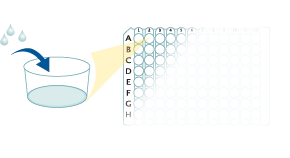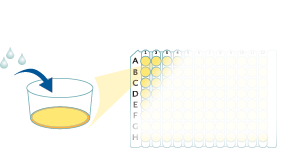Mouse/Rat HGF Quantikine ELISA Kit Summary
Product Summary
Recovery
The recovery of HGF spiked into various matrices was evaluated.
| Sample Type | Average % Recovery | Range % |
|---|---|---|
| Mouse Cell Culture Supernates (n=4) | 98 | 85-106 |
| Mouse Platelet-poor EDTA Plasma (n=4) | 104 | 101-106 |
| Mouse Serum (n=4) | 96 | 84-112 |
| Mouse Tissue Homogenates (n=3) | 87 | 80-101 |
| Rat Cell Culture Supernates (n=4) | 102 | 85-114 |
| Rat Platelet-poor EDTA Plasma (n=4) | 108 | 100-116 |
Linearity
Scientific Data
Product Datasheets
Preparation and Storage
Background: HGF
HGF (Hepatocyte Growth Factor, Scatter Factor) induces the proliferation and migration of epithelial cells, hepatocytes, chondrocytes, keratinocytes, melanocytes, endothelial cells, and many tumor cells. During organogenesis and tissue repair, HGF promotes epithelial/endothelial morphogenesis by inducing cell scattering and branching tubulogenesis. It also supports insulin production by pancreatic beta cells, neuronal survival, and immune tolerance. HGF is secreted as a propeptide that is activated by uPA or HGF Activator at sites of tissue damage. Its signaling through the receptor HGF R/c-MET is enhanced by its prior binding to heparan sulfate proteoglycans. The serum levels of HGF are elevated in a wide range of pathologies including liver damage, acute kidney failure, myocardial infarction, type 1 diabetes, obesity, and cancer, as well as in the synovial fluid of rheumatoid arthritis patients.
Assay Procedure
Refer to the product- Prepare all reagents, standard dilutions, and samples as directed in the product insert.
- Remove excess microplate strips from the plate frame, return them to the foil pouch containing the desiccant pack, and reseal.
- Add 50 µL of Assay Diluent to each well.
- Add 50 µL of Standard, control, or sample to each well. Cover with a plate sealer, and incubate at room temperature for 2 hours.
- Aspirate each well and wash, repeating the process 4 times for a total of 5 washes.
- Add 100 µL of Conjugate to each well. Cover with a new plate sealer, and incubate at room temperature for 2 hours.
- Aspirate and wash 5 times.
- Add 100 µL Substrate Solution to each well. Incubate at room temperature for 30 minutes. PROTECT FROM LIGHT.
- Add 100 µL of Stop Solution to each well. Read at 450 nm within 30 minutes. Set wavelength correction to 540 nm or 570 nm.





Citations for Mouse/Rat HGF Quantikine ELISA Kit
R&D Systems personnel manually curate a database that contains references using R&D Systems products. The data collected includes not only links to publications in PubMed, but also provides information about sample types, species, and experimental conditions.
29
Citations: Showing 1 - 10
Filter your results:
Filter by:
-
Ideal Duration of Pretreatment Using a Gelatin Hydrogel Nonwoven Fabric Prior to Subcutaneous Islet Transplantation
Authors: Saito, R;Inagaki, A;Nakamura, Y;Imura, T;Kanai, N;Mitsugashira, H;Endo, Y;Katano, T;Suzuki, S;Tokodai, K;Kamei, T;Unno, M;Watanabe, K;Tabata, Y;Goto, M;
Cell transplantation
Species: Mouse
Sample Types: Cell Culture Supernates
-
The acid-sensing nociceptor TRPV1 controls breast cancer progression in bone via regulating HGF secretion from sensory neurons
Authors: Okui, T;Hiasa, M;Hata, K;Roodman, GD;Nakanishi, M;Yoneda, T;
Research square
Species: Mouse
Sample Types: Bone Marrow, Serum
-
Combinational Treatment Involving Decellularized Extracellular Matrix Hydrogels With Mesenchymal Stem Cells Increased the Efficacy of Cell Therapy in Pancreatitis
Authors: Kojima, H;Kushige, H;Yagi, H;Nishijima, T;Moritoki, N;Nagoshi, N;Nakano, Y;Tanaka, M;Hori, S;Hasegawa, Y;Abe, Y;Kitago, M;Nakamura, M;Kitagawa, Y;
Cell transplantation
Species: Rat
Sample Types: Cell Culture Supernates
-
Mesenchymal Stem/Stromal Cells in Skeletal Muscle Are Pro-Angiogenic, and the Effect Is Potentiated by Erythropoietin
Authors: Y Iso, S Usui, H Suzuki
Pharmaceutics, 2023-03-24;15(4):.
Species: Rat
Sample Types: Cell Culture Supernates
-
Impact of endothelial nitric oxide synthase activation on accelerated liver regeneration in a rat ALPPS model
Authors: H Masuo, A Shimizu, H Motoyama, K Kubota, T Notake, T Yoshizawa, K Hosoda, K Yasukawa, A Kobayashi, Y Soejima
World Journal of Gastroenterology, 2023-02-07;29(5):867-878.
Species: Rat
Sample Types: Serum
-
Effect of pretreatment with a synbiotic on Perfluorooctanoic acid-induced liver damage after sub-acute oral exposure in C57BL/6J mice
Authors: M Soltani, M Pourfarzam, AH Sharifabad, AK Neisiani, MK Mousavi, M Aliomrani
Toxicology and Applied Pharmacology, 2022-12-23;459(0):116360.
Species: Mouse
Sample Types: Serum
-
Therapeutic effects of adipose-derived mesenchymal stem/stromal cells with enhanced migration ability and hepatocyte growth factor secretion by low-molecular-weight heparin treatment in bleomycin-induced mouse models of systemic sclerosis
Authors: T Suzuka, T Kotani, T Saito, S Matsuda, T Sato, T Takeuchi
Arthritis Research & Therapy, 2022-10-07;24(1):228.
Species: Mouse
Sample Types: Cell Culture Supernates
-
Dry preserved multilayered fibroblast cell sheets are a new manageable tool for regenerative medicine to promote wound healing
Authors: Y Matsuno, M Yanagihara, K Ueno, T Saito, H Kurazumi, R Suzuki, S Katsura, A Oga, K Hamano
Scientific Reports, 2022-07-22;12(1):12519.
Species: Mouse
Sample Types: Cell Lysates
-
Combination Therapy of Placenta-Derived Mesenchymal Stem Cells with WKYMVm Promotes Hepatic Function in a Rat Model with Hepatic Disease via Vascular Remodeling
Authors: JH Jun, S Park, JY Kim, JY Lim, GT Park, JH Kim, GJ Kim
Cells, 2022-01-11;11(2):.
Species: Rat
Sample Types: Cell Culture Supernates
-
Enhanced cellular engraftment of adipose-derived mesenchymal stem cell spheroids by using nanosheets as scaffolds
Authors: H Nagano, Y Suematsu, M Takuma, S Aoki, A Satoh, E Takayama, M Kinoshita, Y Morimoto, S Takeoka, T Fujie, T Kiyosawa
Scientific Reports, 2021-07-14;11(1):14500.
Species: Mouse
Sample Types: Tissue Homogenates
-
Analysis of structural components of decellularized scaffolds in renal fibrosis
Authors: R Zhang, J Jiang, Y Yu, F Wang, N Gao, Y Zhou, X Wan, Z Wang, P Wei, J Mei
Bioactive materials, 2021-01-16;6(7):2187-2197.
Species: Rat
Sample Types: Cell Culture Supernates
-
Antifibrotic therapy by sustained release of low molecular weight heparin from poly(lactic-co-glycolic acid) microparticles on bleomycin-induced pulmonary fibrosis in mice
Authors: T Saito, T Kotani, K Suzuki
Sci Rep, 2020-11-04;10(1):19019.
Species: Mouse
Sample Types: Cell Culture Supernates
-
Topical cell-free conditioned media harvested from adipose tissue-derived stem cells promote recovery from corneal epithelial defects caused by chemical burns
Authors: GW Park, J Heo, JY Kang, JW Yang, JS Kim, KD Kwon, BC Yu, SJ Lee
Sci Rep, 2020-07-24;10(1):12448.
Species: Rat
Sample Types: Cell Culture Supernates
-
The neovascularization effect of dedifferentiated fat cells
Authors: H Watanabe, S Goto, R Kato, S Komiyama, Y Nagaoka, T Kazama, C Yamamoto, Y Li, N Konuma, K Hagikura, T Matsumoto
Sci Rep, 2020-06-08;10(1):9211.
Species: Mouse
Sample Types: Cell Culture Supernates
-
Impaired integrin &alpha5 /&beta1 -mediated hepatocyte growth factor release by stellate cells of the aged liver
Authors: F Rohn, C Kordes, T Buschmann, D Reichert, M Wammers, G Poschmann, K Stühler, AS Benk, F Geiger, JP Spatz, D Häussinger
Aging Cell, 2020-03-11;0(0):e13131.
Species: Rat
Sample Types: Cell Culture Supernates
-
Impact of obesity on breast cancer recurrence and minimal residual disease
Authors: BL Ecker, JY Lee, CJ Sterner, AC Solomon, DK Pant, F Shen, J Peraza, L Vaught, S Mahendra, GK Belka, TC Pan, KH Schmitz, LA Chodosh
Breast Cancer Res., 2019-03-13;21(1):41.
Species: Mouse
Sample Types: Serum
-
Cardiac cell-integrated microneedle patch for treating myocardial infarction
Authors: J Tang, J Wang, K Huang, Y Ye, T Su, L Qiao, MT Hensley, TG Caranasos, J Zhang, Z Gu, K Cheng
Sci Adv, 2018-11-28;4(11):eaat9365.
Species: Rat
Sample Types: Cell Culture Supernates
-
Mesenchymal Stem Cells Modified with Heme Oxygenase-1 Have Enhanced Paracrine Function and Attenuate Lipopolysaccharide-Induced Inflammatory and Oxidative Damage in Pulmonary Microvascular Endothelial Cells
Authors: X Chen, Y Zhang, W Wang, Z Liu, J Meng, Z Han
Cell. Physiol. Biochem., 2018-08-28;49(1):101-122.
Species: Rat
Sample Types: Cell Culture Supernates
-
Decellularized Diaphragmatic Muscle Drives a Constructive Angiogenic Response In Vivo
Authors: ME Alvarèz Fa, M Piccoli, C Franzin, A Sgrò, A Dedja, L Urbani, E Bertin, C Trevisan, P Gamba, AJ Burns, P De Coppi, M Pozzobon
Int J Mol Sci, 2018-04-28;19(5):.
Species: Mouse
Sample Types: Tissue Homogenates
-
Radiofrequency ablation (RFA) induced systemic tumor growth can be reduced by suppression of resultant heat shock proteins
Authors: M Ahmed, G Kumar, S Gourevitch, T Levchenko, E Galun, V Torchilin, SN Goldberg
Int J Hyperthermia, 2018-04-24;0(0):1-25.
Species: Rat
Sample Types: Serum
-
Deletion of Macrophage Mineralocorticoid Receptor Protects Hepatic Steatosis and Insulin Resistance through ER?/HGF/MET Pathway
Authors: YY Zhang, C Li, GF Yao, LJ Du, Y Liu, XJ Zheng, S Yan, JY Sun, Y Liu, MZ Liu, X Zhang, G Wei, W Tong, X Chen, Y Wu, S Sun, S Liu, Q Ding, Y Yu, H Yin, SZ Duan
Diabetes, 2017-03-21;0(0):.
Species: Mouse
Sample Types: Cell Culture Supernates
-
Disrupting the blood-brain barrier by focused ultrasound induces sterile inflammation
Proc. Natl. Acad. Sci. U.S.A, 2016-12-19;0(0):.
Species: Rat
Sample Types: Tissue Homogenates
-
First steps to define murine amniotic fluid stem cell microenvironment
Sci Rep, 2016-11-15;6(0):37080.
Species: Mouse
Sample Types: Amniotic Fluid
-
BubR1 Insufficiency Impairs Liver Regeneration in Aged Mice after Hepatectomy through Intercalated Disc Abnormality
Sci Rep, 2016-08-26;6(0):32399.
Species: Mouse
Sample Types: Tissue Homogenates
-
Regulation of hepatocyte growth factor in mice with pneumonia by peptidases and trans-alveolar flux.
Authors: Raymond W, Xu X, Nimishakavi S, Le C, McDonald D, Caughey G
PLoS ONE, 2015-05-04;10(5):e0125797.
Species: Mouse
Sample Types: BALF
-
Pharmacological Inhibition of KIT Activates MET Signaling in Gastrointestinal Stromal Tumors.
Authors: Cohen N, Zeng S, Seifert A, Kim T, Sorenson E, Greer J, Beckman M, Santamaria-Barria J, Crawley M, Green B, Rossi F, Besmer P, Antonescu C, DeMatteo R
Cancer Res, 2015-04-02;75(10):2061-70.
Species: Mouse
Sample Types: Serum
-
Microvesicles derived from human umbilical cord mesenchymal stem cells facilitate tubular epithelial cell dedifferentiation and growth via hepatocyte growth factor induction.
Authors: Ju, Guan-qun, Cheng, Jun, Zhong, Liang, Wu, Shuai, Zou, Xiang-yu, Zhang, Guang-yu, Gu, Di, Miao, Shuai, Zhu, Ying-jia, Sun, Jie, Du, Tao
PLoS ONE, 2015-03-20;10(3):e0121534.
Species: Rat
Sample Types: Cell Culture Supernates
-
The anti-fibrotic effects of mesenchymal stem cells on irradiated lungs via stimulating endogenous secretion of HGF and PGE2.
Sci Rep, 2015-03-04;5(0):8713.
Species: Rat
Sample Types: Serum
-
Capillary force seeding of hydrogels for adipose-derived stem cell delivery in wounds.
Authors: Garg R, Rennert R, Duscher D, Sorkin M, Kosaraju R, Auerbach L, Lennon J, Chung M, Paik K, Nimpf J, Rajadas J, Longaker M, Gurtner G
Stem Cells Transl Med, 2014-07-18;3(9):1079-89.
Species: Mouse
Sample Types: Protein
FAQs
No product specific FAQs exist for this product, however you may
View all ELISA FAQsReviews for Mouse/Rat HGF Quantikine ELISA Kit
Average Rating: 5 (Based on 2 Reviews)
Have you used Mouse/Rat HGF Quantikine ELISA Kit?
Submit a review and receive an Amazon gift card.
$25/€18/£15/$25CAN/¥75 Yuan/¥2500 Yen for a review with an image
$10/€7/£6/$10 CAD/¥70 Yuan/¥1110 Yen for a review without an image
Filter by:







